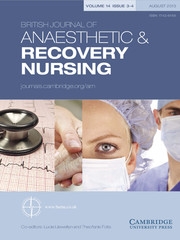Article contents
Cessation of Long-Term Morphine Analgesia - A Case Study
Published online by Cambridge University Press: 25 February 2009
Background
With regard to the problematic use of opioid analgesic drugs, attention is focused not only on those who began using opioids for recreational purposes, but also on those who may become iatrogenically addicted to opioids administered for pain control. It has been suggested that narcotics opioids cause psychological and physical dependence after relatively small therapeutic doses, for a relatively short period of administration Glatt 1974 and that physical dependence may even start to manifest after a single therapeutic dose Qones 1980. Despite these claims, some patients report that they are able to benefit from relatively long-term opioid analgesia without experiencing the effects of problematic drug use that are associated with recreational drug users (Cowan et al 2001, 2002). This issue has obvious implications for anaesthetic and recovery room practitioners who routinely administer opioids to patients in their care. In view of this, the following case study report may be of interest to such practitioners.
- Type
- Research Article
- Information
- British Journal of Anaesthetic & Recovery Nursing , Volume 4 , Issue 1 , February 2003 , pp. 20 - 23
- Copyright
- Copyright © British Association of Anaesthetic and Recovery Nursing 2003
References
REFERENCES
- 2
- Cited by


